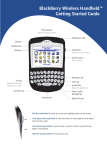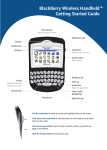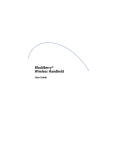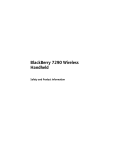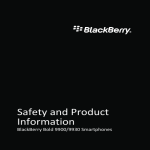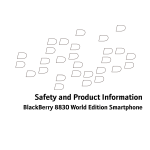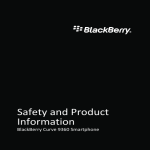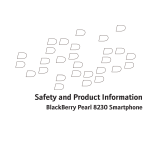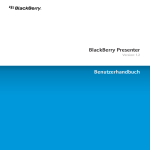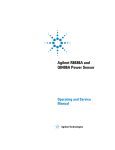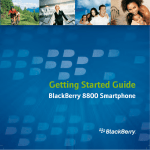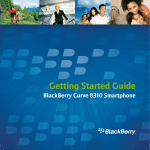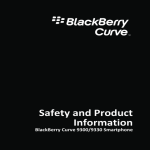Download Blackberry 7250 WIRELESS HANDHELD Specifications
Transcript
BlackBerry Wireless Handheld Safety and Product Information Safety and Product Information BlackBerry 7250 Wireless Handheld™: model number - RAR20CN Last revised: 24 November 2004 Part number: MAT-08547-001 Print specification: PRINTSPEC-002 © 2004 Research In Motion Limited. All rights reserved. The BlackBerry and RIM families of related marks, images and symbols are the exclusive properties and trademarks of Research In Motion Limited. RIM, Research In Motion, 'Always On, Always Connected' and BlackBerry are registered with the U.S. Patent and Trademark Office and may be pending or registered in other countries. cdma2000® is a registered trademark of the Telecommunications Industry Association (TIA-USA) in the United States. cdmaOne™ is a registered trademark of the CDMA Development Group. All other brands, product names, company names, trademarks and service marks are the properties of their respective owners. The Bluetooth® word mark and logos are owned by the Bluetooth SIG, Inc. and any use of such marks by Research In Motion Limited is under license. All other brands, product names, company names, trademarks and service marks are the properties of their respective owners. The handheld and/or associated software are protected by copyright, international treaties and various patents, including one or more of the following U.S. patents: 6,278,442; 6,271,605; 6,219,694; 6,075,470; 6,073,318; D445,428; D433,460; D416,256. Other patents are registered or pending in various countries around the world. Visit www.rim.com/patents.shtml for a current listing of applicable patents. This document is provided “as is” and Research In Motion Limited (RIM) assumes no responsibility for any typographical, technical, or other inaccuracies in this document. RIM reserves the right to periodically change information that is contained in this document; however, RIM makes no commitment to provide any such changes, updates, enhancements, or other additions to this document to you in a timely manner or at all. RIM MAKES NO REPRESENTATIONS, WARRANTIES, CONDITIONS, OR COVENANTS, EITHER EXPRESS OR IMPLIED (INCLUDING, WITHOUT LIMITATION, ANY EXPRESS OR IMPLIED WARRANTIES OR CONDITIONS OF FITNESS FOR A PARTICULAR PURPOSE, NON-INFRINGEMENT, MERCHANTABILITY, DURABILITY, TITLE, OR RELATED TO THE PERFORMANCE OR NON-PERFORMANCE OF ANY SOFTWARE REFERENCED HEREIN, OR PERFORMANCE OF ANY SERVICES REFERENCED HEREIN). IN CONNECTION WITH YOUR USE OF THIS DOCUMENTATION, NEITHER RIM NOR ITS AFFILIATED COMPANIES AND THEIR RESPECTIVE DIRECTORS, OFFICERS, EMPLOYEES, OR CONSULTANTS SHALL BE LIABLE TO YOU FOR ANY DAMAGES WHATSOEVER BE THEY DIRECT, ECONOMIC, COMMERCIAL, SPECIAL, CONSEQUENTIAL, INCIDENTAL, EXEMPLARY, OR INDIRECT DAMAGES, EVEN IF RIM HAS BEEN ADVISED OF THE POSSIBILITY OF SUCH DAMAGES, INCLUDING, WITHOUT LIMITATION, LOSS OF BUSINESS REVENUE OR EARNINGS, LOST DATA, DAMAGES CAUSED BY DELAYS, LOST PROFITS, OR A FAILURE TO REALIZE EXPECTED SAVINGS. Licensed by QUALCOMM Incorporated under one or more of the following United States Patents and/ or their counterparts in other nations: 4,901,307 5,490,165 5,056,109 5,504,773 5,101,501 5,506,865 5,109,390 5,511,073 5,228,054 5,535,239 5,267,261 5,544,196 5,267,262 5,568,483 5,337,338 5,600,754 5,414,796 5,657,420 5,416,797 5,659,569 5,710,784 5,778,338 Research In Motion Limited 295 Phillip Street Waterloo, ON N2L 3W8 Canada Published in XXXXXX Safety and Product Information Booklet Safety information Please read these safety and operation instructions before using the BlackBerry Wireless Handheld™ or any accessories provided with the handheld. Retain these instructions for future use. In some countries there may be restrictions on using Bluetooth® devices. Check with your local authorities. Electrical safety Charge the handheld using only the USB cable ASY-06610-001, Travel charger ASY-04078-001, ASY07559-001, or ASY-07040-001, Automotive charger ASY-04195-001, or other charging accessory provided or specifically approved by Research In Motion Limited (RIM) for use with this handheld. Any approval from RIM under this document must be in writing and must be from a person authorized to provide such approval. Use of any other accessory will invalidate any warranty provided with the handheld and might be dangerous. Use the charging accessories provided with the handheld or any other approved charging accessories only from the type of power source indicated on the marking label. Before using any power supply, verify that the mains voltage is in accordance with the voltage printed on the power supply. Do not overload wall outlets, extension cords, or convenience receptacles as this might result in a risk of fire or electric shock. To reduce the risk of damage to the cord or the plug, pull the plug rather than the cord when you disconnect the charging accessory from the wall outlet or convenience receptacle. Protect the power cord from being walked on or pinched particularly at plugs, convenience receptacles and the point where the power cord connects to the handheld. Unplug charging accessories during lightning storms or when unused for long periods of time. Do not use charging accessories outside or in any area exposed to the elements. Refer to the documentation that came with the handheld for more information on inserting the battery and connecting the power supply. Battery safety and disposal The handheld contains a removable lithium-ion battery. Do not dispose of either the handheld or the lithium battery in a fire. Dispose of the lithium battery in accordance with the laws and regulations in your area governing disposal of such cell types. The battery might present a fire or chemical burn hazard if mistreated. Do not disassemble, crush, or puncture the battery. Do not heat the battery above 60°C (140°F). Do not allow metal objects to contact the battery terminals. Use only the battery that RIM specifies for use with your particular handheld model. Using any other battery will invalidate any warranty provided with the handheld and might present a risk of fire or explosion. Driving safety Check the laws and regulations regarding the use of wireless handhelds in the areas where you drive. Always obey them. Also, if using the handheld as a phone while driving, please use the following guidelines: • Give your full attention to driving; driving safely is your first responsibility. • Use hands-free operation if it is available. • Pull off the road and park before making or answering a phone call. Do not use the other features of the handheld while driving. Have a passenger in the vehicle use the handheld for you, or find a safe location to stop your vehicle prior to using the handheld. 3 Safety and Product Information Booklet Store the handheld safely before driving your vehicle. Do not use any charging accessory as a means of storing the handheld while you are in a vehicle. If your vehicle is equipped with an air bag, do not place the handheld or other objects above the air bag, or in the air bag deployment area. If in-vehicle wireless equipment is improperly stored or installed, and the air bag inflates, serious injury could result. Radio frequency (RF) signals might affect improperly installed or inadequately shielded electronic systems in motor vehicles. Check with the manufacturer or its representative regarding your vehicle. If any equipment has been added to your vehicle, you should also consult the manufacturer of that equipment for information on RF signals. Accessories Use only those accessories approved by RIM. Using any accessories not approved by RIM for use with this particular handheld model will invalidate any approval or warranty applicable to the handheld and might be dangerous. Antenna care Use only the supplied integral antenna. Unauthorized antenna modifications, or attachments could damage the handheld and might violate Federal Communications Commission (FCC) regulations. Operating and storage temperatures Situate the handheld or handheld accessories away from heat sources, such as radiators, heat registers, stoves, or other apparatus (including amplifiers) that produce heat. If you are not going to use the handheld for more than two weeks, turn the handheld power off, remove the battery, and follow the operating and storage temperatures listed below: Handheld operating Handheld storage 32 to 122°F (0 to 50°C) 50 to 77°F (10 to 30°C) Travel charger operating Travel charger storage 32 to 113°F (0 to 45°C) -22 to 167°F (-30 to 75°C) Interference with electronic equipment Most modern electronic equipment is shielded from RF signals. However, certain electronic equipment might not be shielded against the RF signals from the handheld. Pacemakers: Consult a physician or the manufacturer of your pacemaker if you have any questions regarding the effect of RF signals on your pacemaker. If you have a pacemaker, verify that you are using the handheld in accordance with the safety requirements associated with your particular pacemaker, which might include the following: • Always keep the handheld more than 7 inches (20 cm) from the pacemaker when the handheld is turned on. • Do not carry the handheld in your breast pocket. • When using the handheld as a phone, use the ear opposite the pacemaker for making and receiving calls to minimize the potential interference. • If you have any reason to suspect that interference is taking place, turn the handheld radio and the Bluetooth radio off immediately. Hearing aids: Some digital wireless devices may interfere with some hearing aids. In the event of such interference, consult your service provider or contact the manufacturer of your hearing aid to discuss alternatives. Other medical devices: If you use any other personal medical device, consult the manufacturer of your device to determine if they are adequately shielded from external RF energy. Your physician may be able to assist you in obtaining this information. 4 Safety and Product Information Booklet Health care facilities: Turn the handheld radio and the Bluetooth radio off in health care facilities when any regulations posted in these areas instruct you to do so. Hospitals or health care facilities may be using equipment that could be sensitive to external RF energy. Aircraft: Federal Aviation Administration (FAA) and FCC regulations prohibit using the radio of the handheld while in the air. Turn the handheld radio and the Bluetooth radio off before boarding an aircraft. The effect of using the handheld radio or the Bluetooth radio in an aircraft is unknown. Such use might affect aircraft instrumentation, communication and performance, might disrupt the network, might otherwise be dangerous to the operation of the aircraft, and might be illegal. Use any other handheld applications in accordance with airline regulations for electronic devices. Dangerous areas Potentially explosive atmospheres: Turn the handheld radio and the Bluetooth radio off when in any area with a potentially explosive atmosphere, and obey all signs and instructions. Sparks in such areas could cause an explosion or fire resulting in bodily injury or even death. Areas with a potentially explosive atmosphere are often, but not always, clearly marked. They include fueling areas such as gasoline or petrol stations; below deck on boats; fuel or chemical transfer or storage facilities; vehicles using liquefied petroleum gas (such as propane or butane); areas where the air contains chemicals or particles, such as grain, dust, or metal powders; and any other area where you would normally be advised to turn off your vehicle engine. Do not use the handheld phone to report a gas leak in the vicinity of the leak. Leave the area and make the call from a safe location. Blasting areas: To avoid interfering with blasting operations, turn the handheld radio and the Bluetooth radio off when in a “blasting area” or in areas posted: “Turn off two-way radio”. Obey all signs and instructions. Service Only qualified service personnel should perform repairs to the handheld. Disconnect the power supply cables from the computer or electrical outlet and refer the handheld or charging accessory for service to qualified service personnel if any of the following situations occur: • the power supply cord, plug, or connector is damaged • liquid has been spilled or objects have fallen into the handheld or charging accessory • the handheld or charging accessory has been exposed to rain or water • the handheld or charging accessory becomes very hot to the touch • the handheld or charging accessory has been dropped or damaged in any way • the handheld or charging accessory does not operate normally by following the instructions in the user documentation • the handheld or charging accessory exhibits a distinct change in performance Do not attempt to disassemble the handheld or any charging accessory. To reduce the risk of fire or electric shock, adjust only those controls that are covered in the user documentation for the handheld. An improper adjustment of other controls might cause damage and will often require extensive work by a qualified technician to restore the handheld, charging accessory, or any other accessory to normal operation. Failure to observe all safety instructions contained in the user documentation for the handheld will void the Limited Warranty and might lead to suspension or denial of services to the offender, legal action, or both. 5 Safety and Product Information Booklet Additional safety guidelines Liquids and foreign objects: Never push objects of any kind into the handheld or handheld accessories through openings as this action might short circuit parts and cause a fire or electric shock. Do not use the handheld or handheld accessories near water (for example, near a bathtub or a sink, in a wet basement, or near a swimming pool). Never spill liquid of any kind on the handheld or handheld accessories. Stability: Do not place the handheld or handheld accessory on any unstable surface. It could fall, thereby potentially causing serious injury to a person and serious damage to the handheld or handheld accessory. Take care when using the handheld with any charging accessories to route the power cord in a way that reduces the risk of injury to others, such as by tripping or choking. Cleaning: Do not use liquid, aerosol cleaners, or solvents on or near the handheld or handheld accessory. Clean only with a dry cloth. Disconnect any cables from the computer and unplug any charging accessories from the electrical outlet before cleaning either the handheld or the charging accessory. Compliance information Exposure to radio frequency signals The BlackBerry Wireless Handheld is a low power radio transmitter and receiver. When the handheld radio is on, it receives and also sends out RF signals. The handheld complies with U.S. Federal Communications Commission (FCC) and Industry Canada (IC) guidelines respecting safety levels of RF exposure for wireless handheld devices, which in turn are consistent with the following safety standards previously set by Canadian, U.S., and international standards bodies: • ANSI/IEEE C95.1, 1999, IEEE Standard for Safety Levels with Respect to Human Exposure to Radio Frequency Electromagnetic Fields, 3 kHz to 300 GHz • National Council on Radiation Protection and Measurements (NCRP) Report 86, 1986, Biological Effects and Exposure Criteria for Radio Frequency Electromagnetic Fields • Health Canada, Safety Code 6, 1999, Limits of Human Exposure to Radio Frequency Electromagnetic Fields in the Frequency Range from 3 kHz to 300 GHz • International Commission on Non-Ionizing Radiation Protection (ICNIRP), 1998, Guidelines for limiting exposure to time-varying electric, magnetic, and electromagnetic fields (up to 300 GHz) To maintain compliance with FCC and IC RF exposure guidelines, when carrying the handheld on your body, use RIM-supplied or approved accessories, or accessories that contain no metallic components and provide a separation distance from the body of at least 15 mm (0.60 inches). Use of other accessories might violate FCC and IC RF exposure guidelines and might void any warranty applicable to the handheld. For data operation (when you do not use a body-worn accessory and are not holding the handheld at the ear), position the handheld at least 15 mm (0.60 inches) from the body. Specific absorption rate data THIS MODEL WIRELESS HANDHELD MEETS GOVERNMENT REQUIREMENTS FOR EXPOSURE TO RADIO WAVES. The BlackBerry Wireless Handheld is a radio transmitter and receiver. It is designed and manufactured not to exceed the emission limits for exposure to radio frequency (RF) energy set by the Federal Communications Commission (FCC) of the U.S. Government and Industry Canada of the Canadian Government (IC). These limits are part of comprehensive guidelines and establish permitted levels of RF energy for the general population. The guidelines are based on standards that were developed by independent scientific organizations through periodic and thorough evaluation of scientific studies. The standards include a substantial safety margin designed to assure the safety of all persons, regardless of age and health. 6 Safety and Product Information Booklet The exposure standard for wireless mobile handhelds employs a unit of measurement known as the Specific Absorption Rate, or SAR. The SAR limit set by the FCC/IC is 1.6W/kg*. Tests for SAR are conducted using standard operating positions specified by the FCC/IC with the handheld transmitting at its highest certified power level in all tested frequency bands. Although the SAR is determined at the highest certified power level, the actual SAR level of the handheld while operating can be well below the maximum value. This is because the handheld is designed to operate at multiple power levels so as to use only the power required to reach the network. In general, the closer you are to a wireless base station antenna, the lower the power output. Before a wireless handheld model is available for sale to the public, it must be tested and certified to the FCC and IC that it does not exceed the limit established by the government-adopted requirement for safe exposure under the recommendations of the International Commission on Non-Ionizing Radiation Protection (ICNIRP). The tests are performed in positions and locations (for example, at the ear and worn on the body) as required by the FCC, IC and for each model. The highest SAR values for each handheld model when tested for use at the ear is outlined below: Handheld BlackBerry 7250 Wireless Handheld™ 1 g SAR (W/kg) 0.53 The highest SAR values for each handheld model when worn on the body, in an approved holster or carrying case, is outlined below: Handheld BlackBerry 7250 Wireless Handheld™ 1 g SAR (W/kg) 0.84 Body-worn measurements differ among wireless handheld and phone models, depending upon available accessories and FCC and IC requirements. While there may be differences between the SAR levels of various wireless devices and at various positions, they all meet the government requirement for safe exposure. The FCC has granted an Equipment Authorization for this model handheld with all reported SAR levels evaluated as in compliance with the FCC RF emission guidelines. SAR information on this model handheld is on file with the FCC and can be found under the Display Grant section of http:// www.fcc.gov/oet/fccid after searching on FCC ID L6ARAR20CN. Additional information on Specific Absorption Rates (SAR) can be found on the Cellular Telecommunications & Internet Association (CTIA) web-site at http://www.wow-com.com. ___________________________________ * In the United States and Canada, the SAR limit for mobile handhelds used by the public is 1.6 watts/ kg (W/kg) averaged over one gram of tissue for the body or head (4.0 W/kg averaged over 10 grams of tissue for the extremities - hands, wrists, ankles and feet). The standard incorporates a substantial margin of safety to give additional protection for the public and to account for any variations in measurements. The long-term characteristics or the possible physiological effects of Radio Frequency Electromagnetic fields have not been evaluated by Underwriters Laboratories Inc. (UL). 7 Safety and Product Information Booklet FCC compliance statement (USA) FCC Class B Part 15 This device complies with Part 15 of the FCC Rules. Operation is subject to the following two conditions: • This device may not cause harmful interference, and • This device must accept any interference received, including interference that may cause undesired operation. Warning: Changes or modifications to this unit not expressly approved by the party responsible for compliance could void the user’s authority to operate this equipment. This equipment has been tested and found to comply with the limits for a Class B digital device, pursuant to Part 15 of the FCC Rules. These limits are designed to provide reasonable protection against harmful interference in a residential installation. This equipment generates, uses and can radiate radio frequency energy and, if not installed and used in accordance with the manufacturer’s instructions, may cause interference harmful to radio communications. There is no guarantee, however, that interference will not occur in a particular installation. If this equipment does cause harmful interference to radio or television reception, which can be determined by turning the equipment off and on, the user is encouraged to try to correct the interference by one or more of the following measures: • Reorient or relocate the receiving antenna. • Increase the separation between the equipment and receiver. • Connect the equipment to an outlet on a circuit different from that to which the receiver is connected. • Consult the dealer or an experienced radio or TV technician for help. Industry Canada certification This device complies with Industry Canada RSS 129, RSS 133 and RSS 210 under certification number 2503A-RAR20CN. Class B compliance This device complies with the Class B limits for radio noise emissions as set out in the interferencecausing equipment standard entitled “Digital Apparatus,” ICES-003 of Industry Canada. Additional regulatory conformance Specific details about compliance to the following standard and regulatory body may be obtained from Research In Motion: • Underwriters Laboratories UL60950 requirements for Canada and the United States 8 Safety and Product Information Booklet Product information Mechanical properties Weight Size (L x W x H) Memory Approximately 142 g (5 oz.) including battery 113 x 74 x 22 mm (4.4 x 2.9 x 0.8 in) 32 MB flash memory, 4 MB SRAM Power Battery Port Removable, rechargeable lithium-ion cell USB compatible port for data synchronization and charging Radio specifications BlackBerry 7250 Wireless Handheld Dual-band support 800/1900 MHz CDMA Networks CDMA2000® 1X/cdmaOne™ Power class Class 3 (Cell band), Class 2 (PCS band) Transmitting frequency Cell 824.70 to 848.31 MHz, PCS 1851.25 to 1908.75 MHz Receiving frequency Cell 869.70 to 893.31 MHz, PCS 1931.25 to 1988.75 MHz, A-GPS E911: 1575 MHz Bluetooth Radio Single-band support ISM 2.4 GHz Power class Bluetooth class 2 (2.5 mW) Transmitting and receiving frequency 2402 to 2480 MHz 9









